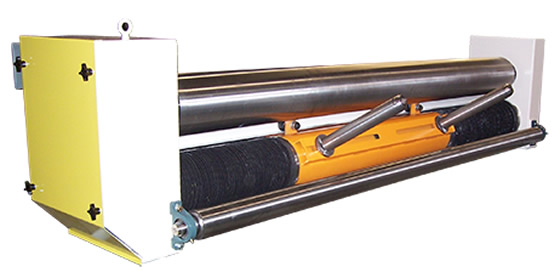 Since 1946, Akron Steel Fabricators (ASF) has supplied the rubber industry with consistent, dependable, and productive mill room equipment.
Since 1946, Akron Steel Fabricators (ASF) has supplied the rubber industry with consistent, dependable, and productive mill room equipment.The mill blender, an accessory that mounts on top of a mixing mill, has a threefold purpose:
- Blending, by pulling rubber off the front face of a mill roll and diverting it back into the rolling blank before the bite or gap between the two mill rolls.
- Guiding, to assist the mill operator in manipulating the rubber to a particular position as it is removed from the mill.
- Circulating, achieved by moving rubber off and then back on the mill. Circulation reduces time and temperature exposure that contribute to scorching and scrap product.
While mill blender purpose has remained somewhat static, over the last twenty years, a steady evolution has taken place in mill blender design, driven by demands of the rubber industry that focus on the “four Cs”: Clean, Consistent, Controllable, Compact.
Akron Steel Fabricators (ASF), a Poling Group company, has positioned itself as a leader throughout this evolution with innovation that focuses on the same goals.
Clean
The potential for batch contamination remains a major problem for many legacy mill blenders with a Yankee screw, traditionally chosen because of its consistent and controllable traversing speeds. However, because the Yankee screw requires constant lubrication and traverses across the face of the mill, the inherent design results in a high potential for grease to drip into the batch. Also, its open exposure increases the probability of lubricant mixing with airborne particulates, further contaminating the rubber.
ASF solved the batch contamination problem by reinventing the mill blender with a contained ball screw that provides consistent speed control. By housing the ball screw shaft and nut within an enclosed tube, ASF isolated it from any contamination from the mill and at the same time, eliminated the potential for the mill blender to introduce lubrication and other contaminates into the milled product. The metal tube enclosing the ball screw also functions as a bearing surface for the reciprocating carriage.
Consistent
Another benefit of the ASF mill blender is the consistent and repeatable way it blends rubber compounds on a mill. Constant weaving of the stock returning to the roll bite promotes better mixing, blending, and kneading – allowing larger batches and resulting in shorter cycle times and a reduced danger of scalding. Reduced temperature is obtained by separating the batch from the mill roll and passing it over the cooled drive roll before it returns to the bite.
Controllable
The controllability of a carriage associated with a traditional Yankee screw design mill blender is limited to a fixed distance. This limitation is due to the fact that the Yankee screw nut must move to the ends of the threads to reciprocate in the opposite direction.
In contrast, the ASF ball screw design increases the controllability of the carriage. By reversing the rotational direction of the ball screw shaft, the mill operator can choose the travel distance of the carriage. Variable frequency drives control the speed of the main drive roll and carriage travel, enabling the speed of the mill blender to follow the speed of the mill. The control system captures the number of carriage traverses across its length of travel, so the user can develop recipes for the amount of time the rubber is blended as well as how much work is placed into the product.
Compact
ASF also found unique ways to make a more compact and precise mill blender that is truly adaptable to various mill room situations:
- By shortening the overall profile, the ASF mill blender fits into the area above mill frames with less available space. The reduction in height also made the main drive roll lower and closer to the operator, making the initial threading of the mill blender considerably easier.
- The elevation of the carriage was brought closer to the operator to make it more accessible for cleaning.
In addition to meeting the “four Cs” challenge, ASF improved safety and ease of operation by redesigning its mill blender with a new bracket that provides a larger gap between the main drive roll and pinch roll. The larger opening provides a larger target to receive the leading edge of the rubber thrown to it. Locating the pinch roll on the back side of the drive roll keeps it safely out of the reach of the operator.
Standard Features
- Adjustable carriage travel
- Large carriage bearings
- No grooved screw lubrication
- Remanufacturing to bring your initial investments back to the original or new specification
- No batch contamination from grease falling
- Water-cooled turn roll
- Directional valve for positioning carriage (manual and automatic)
- Adjustable carriage reciprocation to preset stops
- Adjustable carriage speed independent of blender roll speed
- Low and narrow profile requires less space and can be used on drop mills
- Standard design up to 100" rollface